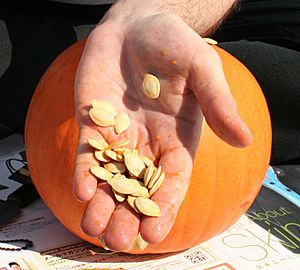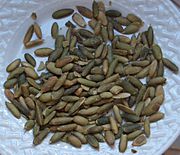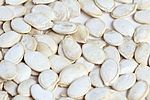Pumpkin seed facts for kids
A pumpkin seed, also known in North America as a pepita (from the Mexican Spanish: pepita de calabaza, "little seed of squash"), is the edible seed of a pumpkin or certain other cultivars of squash. The seeds are typically flat and asymmetrically oval, have a white outer husk, and are light green in color after the husk is removed. Some cultivars are huskless, and are grown only for their edible seed. The seeds are nutrient- and calorie-rich, with especially high content of fat (particularly linoleic acid and oleic acid), protein, dietary fiber, and numerous micronutrients. Pumpkin seed can refer either to the hulled kernel or unhulled whole seed, and most commonly refers to the roasted end product used as a snack.
Cuisine
Pumpkin seeds are a common ingredient in Mexican cuisine and are also roasted and served as a snack. Marinated and roasted, they are an autumn seasonal snack in the United States, as well as a commercially produced and distributed packaged snack, like sunflower seeds, available year-round. Pepitas are known by their Spanish name (usually shortened), and typically salted and sometimes spiced after roasting (and today also available as a packaged product), in Mexico and other Latin American countries, in the American Southwest, and in specialty and Mexican food stores.
The earliest known evidence of the domestication of Cucurbita dates back 8,000–10,000 years ago, predating the domestication of other crops such as maize and common beans in the region by about 4,000 years. Changes in fruit shape and color indicate intentional breeding of C. pepo occurred by no later than 8,000 years ago. The process to develop the agricultural knowledge of crop domestication took place over 5,000–6,500 years in Mesoamerica. Squash was domesticated first, with maize second, followed by beans, all becoming part of the Three Sisters agricultural system.
As an ingredient in mole dishes, they are known in Spanish as pipián. A Mexican snack using pepitas in an artisan fashion is referred to as pepitoría. Lightly roasted, salted, unhulled pumpkin seeds are popular in Greece with the descriptive Italian name, passatempo ("pastime").
The pressed oil of the roasted seeds of a Cucurbita pepo subsp. pepo var. 'styriaca' is also used in Central and Eastern Europe as cuisine. An example of this is pumpkin seed oil. Pumpkin seeds can also be made into a nut butter.
Nutrition
| Nutritional value per 100 g (3.5 oz) | |
|---|---|
| Energy | 2,401 kJ (574 kcal) |
|
14.71 g
|
|
| Sugars | 1.29 g |
| Dietary fiber | 6.5 g |
|
49.05 g
|
|
| Saturated | 8.544 g |
| Monounsaturated | 15.734 |
| Polyunsaturated | 19.856 |
|
Protein
|
29.84 g
|
| Vitamins | Quantity
%DV†
|
| Thiamine (B1) |
6%
0.07 mg |
| Riboflavin (B2) |
13%
0.15 mg |
| Niacin (B3) |
28%
4.43 mg |
| Pantothenic acid (B5) |
11%
0.57 mg |
| Vitamin B6 |
8%
0.1 mg |
| Folate (B9) |
14%
57 μg |
| Vitamin C |
8%
6.5 mg |
| Vitamin E |
4%
0.56 mg |
| Vitamin K |
4%
4.5 μg |
| Minerals | Quantity
%DV†
|
| Calcium |
5%
52 mg |
| Iron |
62%
8.07 mg |
| Magnesium |
155%
550 mg |
| Manganese |
214%
4.49 mg |
| Phosphorus |
168%
1174 mg |
| Potassium |
26%
788 mg |
| Sodium |
17%
256 mg |
| Zinc |
80%
7.64 mg |
| Other constituents | Quantity |
| Water | 2.0 g |
|
Link to USDA Database entry
|
|
| †Percentages estimated using US recommendations for adults. | |
Dried, roasted pumpkin seeds are 2% water, 49% fat, 15% carbohydrates, and 30% protein (table). In a 100 gram reference serving, the seeds are calorie-dense (574 kcal), and a rich source (20% of the Daily Value, DV, or higher) of protein, dietary fiber, niacin, iron, zinc, manganese, magnesium, and phosphorus (table). The seeds are a moderate source (10–19% DV) of riboflavin, folate, pantothenic acid, sodium, and potassium (table). Major fatty acids in pumpkin seeds are linoleic acid and oleic acid, with palmitic acid and stearic acid in lesser amounts.
Benefits
- As pumpkin seeds are a good source of magnesium, potassium, polyunsaturated fatty acids and calcium, consuming pumpkin seeds help to increase bone, heart and other body function health.
- Pumpkins seeds are a good source of vitamins and fatty acids that can help manage type II Diabetes.
- Pumpkin seeds are a rich source of zinc, and other nutrients that improve liver health and health during pregnancy.
- As pumpkin seeds are high in fiber, eating pumpkin seeds can improve weight loss and digestion.
- The high content of vitamin E in pumpkin seeds, helps strengthen the immune system.
- Pumpkin Seeds, a Natural Source of Tryptophan/ a-amino acid, increases insomnia prevention.
- Pumpkin seeds increase skin and eye health, being a good source of beta-carotene.
Oil
The oil of pumpkin seeds, a culinary specialty in and important export commodity of Central Europe, is used in cuisine as a salad and cooking oil.
The following are ranges of fatty acid content in C. maxima pepitas (see pumpkin seed oil):
| n:unsat | Fatty acid name | Percentage range |
|---|---|---|
| (14:0) | Myristic acid | 0.003–0.056 |
| (16:0) | Palmitic acid | 1.6–8.0 |
| (16:1) | Palmitoleic acid | 0.02–0.10 |
| (18:0) | Stearic acid | 0.81–3.21 |
| (18:1) | Oleic acid | 3.4–19.4 |
| (18:2) | Linoleic acid | 5.1–20.4 |
| (18:3) | Linolenic acid | 0.06–0.22 |
| (20:0) | Arachidic acid | 0.06–0.21 |
| (20:1) | Gadoleic acid | 0–0.035 |
| (22:0) | Behenic acid | 0.02–0.12 |
The total unsaturated fatty acid concentration ranged from 9% to 21% of the pepita. The total fat content ranged from 11% to 52%. Based on the quantity of alpha-tocopherol extracted in the oil, the vitamin E content of twelve C. maxima cultivar seeds ranged from 4 to 19 mg/100 g of pepita.
Traditional medicine
Pumpkin seeds were once used as an anthelmintic in traditional medicine in China to expel tapeworms parasites, such as Taenia tapeworms. This led to the seeds being listed in the United States Pharmacopoeia as an antiparasitic from 1863 until 1936.
Market
Due to their versatility as a food product ingredient or snack, pumpkin seeds are projected to grow in sales by 13% annually and reach $631 million from 2020 to 2024. Demand from China and new varieties having seeds without hulls to make them easier to digest are major reasons for increased growth.
See also
 In Spanish: Pepita de calabaza para niños
In Spanish: Pepita de calabaza para niños




